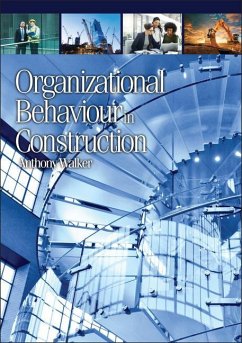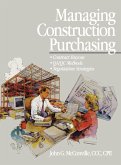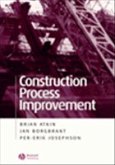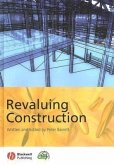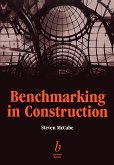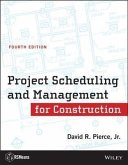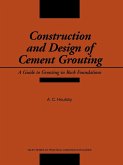Anthony Walker
Organizational Behaviour in Construction
Anthony Walker
Organizational Behaviour in Construction
- Broschiertes Buch
- Merkliste
- Auf die Merkliste
- Bewerten Bewerten
- Teilen
- Produkt teilen
- Produkterinnerung
- Produkterinnerung
The core of all successful organizations is the effectiveness with which people work together. Individuals have differing characteristics and personalities, and the manner in which they interact is the key to meeting organizational objectives. This is the case for all organizations, but particularly so in construction, which is distinctly different from other industries. Construction is complex and highly differentiated, with a wide range of specialists with disparate professional skills working in a highly integrated way to deliver projects successfully. Understanding how the people involved…mehr
Andere Kunden interessierten sich auch für
![Managing Construction Purchasing Managing Construction Purchasing]() John G McConvilleManaging Construction Purchasing93,99 €
John G McConvilleManaging Construction Purchasing93,99 €![Smith, Currie & Hancock's Federal Government Construction Contracts Smith, Currie & Hancock's Federal Government Construction Contracts]() Thomas J KelleherSmith, Currie & Hancock's Federal Government Construction Contracts148,99 €
Thomas J KelleherSmith, Currie & Hancock's Federal Government Construction Contracts148,99 €![Construction Process Improvement Construction Process Improvement]() Brian Atkin / Jan Borgbrant / Per-Erik JosephsonConstruction Process Improvement144,99 €
Brian Atkin / Jan Borgbrant / Per-Erik JosephsonConstruction Process Improvement144,99 €![Revaluing Construction Revaluing Construction]() Peter BarrettRevaluing Construction171,99 €
Peter BarrettRevaluing Construction171,99 €![Benchmarking in Construction Benchmarking in Construction]() Steven MccabeBenchmarking in Construction129,99 €
Steven MccabeBenchmarking in Construction129,99 €![Project Scheduling and Management for Construction Project Scheduling and Management for Construction]() David R PierceProject Scheduling and Management for Construction113,99 €
David R PierceProject Scheduling and Management for Construction113,99 €![Construction and Design of Cement Grouting Construction and Design of Cement Grouting]() A C HoulsbyConstruction and Design of Cement Grouting249,99 €
A C HoulsbyConstruction and Design of Cement Grouting249,99 €-
-
-
The core of all successful organizations is the effectiveness with which people work together. Individuals have differing characteristics and personalities, and the manner in which they interact is the key to meeting organizational objectives. This is the case for all organizations, but particularly so in construction, which is distinctly different from other industries. Construction is complex and highly differentiated, with a wide range of specialists with disparate professional skills working in a highly integrated way to deliver projects successfully. Understanding how the people involved in construction behave and work together is necessary for projects to have successful outcomes. Organizational behaviour is an established field in mainstream management literature but general treatments cannot reflect the specific issues and idiosyncrasies of the construction industry and the people who inhabit it. Organizational Behaviour in Construction addresses the behaviour of individuals and groups within the different organizations which come together on construction projects and within the organizations created to manage projects. It describes how their behaviour impacts on the performance of construction organizations and their contribution to the project as a whole. Drawing on mainstream organizational literature but putting it into the specific context of construction, and containing many illustrations drawn from the industry, this book will be required reading for all senior undergraduate and postgraduate students of construction, as well as middle and senior management in the industry.
Hinweis: Dieser Artikel kann nur an eine deutsche Lieferadresse ausgeliefert werden.
Hinweis: Dieser Artikel kann nur an eine deutsche Lieferadresse ausgeliefert werden.
Produktdetails
- Produktdetails
- Verlag: Wiley
- Seitenzahl: 336
- Erscheinungstermin: 20. Juni 2011
- Englisch
- Abmessung: 239mm x 170mm x 20mm
- Gewicht: 590g
- ISBN-13: 9781405189576
- ISBN-10: 1405189576
- Artikelnr.: 33654777
- Herstellerkennzeichnung
- Libri GmbH
- Europaallee 1
- 36244 Bad Hersfeld
- 06621 890
- Verlag: Wiley
- Seitenzahl: 336
- Erscheinungstermin: 20. Juni 2011
- Englisch
- Abmessung: 239mm x 170mm x 20mm
- Gewicht: 590g
- ISBN-13: 9781405189576
- ISBN-10: 1405189576
- Artikelnr.: 33654777
- Herstellerkennzeichnung
- Libri GmbH
- Europaallee 1
- 36244 Bad Hersfeld
- 06621 890
About the Author Anthony Walker BBS, MSc, PhD, FRICS, holds the title of Professor Emeritus in Real Estate and Construction at the University of Hong Kong, where he has been engaged in teaching and research since 1985, prior to which he held academic appointments in the United Kingdom. He is a chartered surveyor and has worked in Britain, the Middle East and the Far East.
Preface viii
1 Introduction 1
1.1 What is organizational behaviour? 2
1.2 Critiques of organizational behaviour 5
1.3 Working in construction 6
1.4 An illustration 7
1.5 The development of organizational behaviour 9
1.6 Organizational behaviour, common sense and research 13
1.7 The rationale of this book 14
2 Individual Behaviour 16
2.1 The constituents 16
2.2 Ability 16
2.3 Attitudes 17
2.4 Attitude and behaviour 18
2.5 Job satisfaction 20
2.6 Job satisfaction and performance 23
2.7 Job satisfaction and organizational citizenship behaviour 26
2.8 Job satisfaction and client satisfaction 27
2.9 Job satisfaction, turnover and absenteeism 28
2.10 Personality 29
2.11 Personality assessment 35
2.12 Values 38
2.13 Personality, values and the construction professions 39
2.14 Perception 43
2.15 Creativity 49
2.16 The significance of individual behaviour for construction 49
3 Emotions, Feelings and Stress 52
3.1 Rationality 52
3.2 Emotions and moods 53
3.3 Disguising emotions 55
3.4 Emotional stereotyping and emotional cultures 56
3.5 Emotional Intelligence 58
3.6 Stress 60
3.7 Causes of stress 62
3.7.1 Work stressors 62
3.7.2 Non-work stressors 67
3.8 Differences in individual responses to stress 68
3.9 Consequences of stress 70
3.9.1 Burnout 71
3.10 Managing work-related stress 72
4 Morality, Ethics and Trust 75
4.1 Introduction 75
4.2 The nature and scope of ethical behaviour in business organizations 77
4.3 Organizational pressures 80
4.4 Specific issues of ethics in business 84
4.5 Professional ethics in construction 86
4.5.1 Codes of conduct 93
4.6 Trust 95
4.6.1 Types of trust 97
4.6.2 Antecedents of trust 100
4.6.3 The rational-choice approach 101
4.6.4 Trust in construction 102
4.6.5 Trust and transaction cost economics 104
5 Motivation 107
5.1 Introduction 107
5.2 Content theories of motivation 110
5.3 Process theories of motivation 115
5.4 Job design and job enrichment 123
5.5 Empowerment 125
5.6 Rewarding employees 128
5.7 A critique 130
6 Communications 133
6.1 Introduction 133
6.2 The communication process 135
6.3 Communication channels 138
6.3.1 Face-to-face communication 138
6.3.2 Non-verbal communication 139
6.3.3 Impression management 141
6.4 Listening 141
6.5 Questioning 142
6.6 Barriers and issues 143
6.7 Aspects of organizational communication 148
6.8 End piece 151
7 Authority, Power and Politics 153
7.1 Introduction 153
7.2 Authority 154
7.3 Power 156
7.4 Relationship between authority and power 157
7.5 Sources of power 158
7.6 Personality and power 161
7.7 Politics in organizations 162
7.8 Types of political activity 165
7.9 The ethics of political behaviour 166
7.10 Power and leadership 166
7.11 Authority and power in the construction process 167
7.11.1 Power within client organizations 169
7.11.2 Power and project team members 170
7.12 Politics, projects and firms 172
7.13 Empowerment again 173
7.13.1 Empowerment and projects 174
8 Culture 177
8.1 Introduction 177
8.2 Definitions 178
8.3 Critiques of organizational culture 179
8.4 Organizational climate 181
8.5 Organizational culture, types and performance 182
8.5.1 Types of organizational culture 183
8.5.2 Adaptive cultures 184
8.6 Corporate image 185
8.7 Applications to construction organizations 185
8.8 Observable aspects of culture 187
8.9 Creating, sustaining and changing organizational culture 189
8.10 Cultures, subcultures and construction 191
8.11 Culture and ethics 194
8.12 Industry cultures 195
8.13 National cultures 198
9 Groups and Teams 201
9.1 Introduction 201
9.2 Defining groups and teams 202
9.3 Critique 203
9.4 Teams in construction organizations 206
9.5 Types of group and team 207
9.6 Structure and roles 214
9.6.1 Structure 214
9.6.2 Roles 215
9.7 Group development 218
9.7.1 Team building 218
9.7.2 Managing groups 219
9.7.3 Size and composition 220
9.7.4 Norms 221
9.7.5 Leadership 221
9.8 Behaviour in teams 222
9.9 Teams in general vs. project teams in construction 228
10 Decision-making 232
10.1 Introduction 232
10.2 The rational model 233
10.3 The types and nature of decisions 235
10.4 Behaviour in decision-making 236
10.5 Group decision-making 242
10.6 Group decision-making techniques 252
11 Leadership, Learning and Change 254
11.1 Introduction 254
11.2 Traits approach 256
11.3 Behavioural approach 257
11.4 Democratic vs. autocratic leadership styles 259
11.5 Contingency approach 259
11.5.1 Fielder's model 260
11.5.2 Situational leadership 262
11.6 Path-goal theory 265
11.7 Vroom's decision tree approach 266
11.8 Adopting different leadership styles 267
11.9 Leader-member exchange theory 268
11.10 Inspirational approaches 269
11.10.1 Charismatic leadership 269
11.10.2 Transformational (and transactional) leadership 270
11.11 Authentic leaders 271
11.12 More widely-based leadership 271
11.13 Leadership in perspective 272
11.13.1 Attributing leadership 273
11.13.2 Leadership substitutes and neutralizers 273
11.14 Leaders' perceptions 274
11.15 Women as leaders 275
11.16 Culture and leadership 276
11.17 Leadership in construction 277
11.17.1 Leadership of construction-related organizations 277
11.17.2 Leadership and the client's interdisciplinary project team leader
282
11.17.3 Project leadership qualities 287
11.18 Learning organizations and organizational change 289
11.19 The learning organization 289
11.20 Organizational change 294
11.20.1 Change agents 297
11.20.2 Resistance to change 297
11.20.3 Business process re-engineering 298
11.20.4 Processual/contextual perspectives 299
11.20.5 Organizational development 299
References 302
Index 323
1 Introduction 1
1.1 What is organizational behaviour? 2
1.2 Critiques of organizational behaviour 5
1.3 Working in construction 6
1.4 An illustration 7
1.5 The development of organizational behaviour 9
1.6 Organizational behaviour, common sense and research 13
1.7 The rationale of this book 14
2 Individual Behaviour 16
2.1 The constituents 16
2.2 Ability 16
2.3 Attitudes 17
2.4 Attitude and behaviour 18
2.5 Job satisfaction 20
2.6 Job satisfaction and performance 23
2.7 Job satisfaction and organizational citizenship behaviour 26
2.8 Job satisfaction and client satisfaction 27
2.9 Job satisfaction, turnover and absenteeism 28
2.10 Personality 29
2.11 Personality assessment 35
2.12 Values 38
2.13 Personality, values and the construction professions 39
2.14 Perception 43
2.15 Creativity 49
2.16 The significance of individual behaviour for construction 49
3 Emotions, Feelings and Stress 52
3.1 Rationality 52
3.2 Emotions and moods 53
3.3 Disguising emotions 55
3.4 Emotional stereotyping and emotional cultures 56
3.5 Emotional Intelligence 58
3.6 Stress 60
3.7 Causes of stress 62
3.7.1 Work stressors 62
3.7.2 Non-work stressors 67
3.8 Differences in individual responses to stress 68
3.9 Consequences of stress 70
3.9.1 Burnout 71
3.10 Managing work-related stress 72
4 Morality, Ethics and Trust 75
4.1 Introduction 75
4.2 The nature and scope of ethical behaviour in business organizations 77
4.3 Organizational pressures 80
4.4 Specific issues of ethics in business 84
4.5 Professional ethics in construction 86
4.5.1 Codes of conduct 93
4.6 Trust 95
4.6.1 Types of trust 97
4.6.2 Antecedents of trust 100
4.6.3 The rational-choice approach 101
4.6.4 Trust in construction 102
4.6.5 Trust and transaction cost economics 104
5 Motivation 107
5.1 Introduction 107
5.2 Content theories of motivation 110
5.3 Process theories of motivation 115
5.4 Job design and job enrichment 123
5.5 Empowerment 125
5.6 Rewarding employees 128
5.7 A critique 130
6 Communications 133
6.1 Introduction 133
6.2 The communication process 135
6.3 Communication channels 138
6.3.1 Face-to-face communication 138
6.3.2 Non-verbal communication 139
6.3.3 Impression management 141
6.4 Listening 141
6.5 Questioning 142
6.6 Barriers and issues 143
6.7 Aspects of organizational communication 148
6.8 End piece 151
7 Authority, Power and Politics 153
7.1 Introduction 153
7.2 Authority 154
7.3 Power 156
7.4 Relationship between authority and power 157
7.5 Sources of power 158
7.6 Personality and power 161
7.7 Politics in organizations 162
7.8 Types of political activity 165
7.9 The ethics of political behaviour 166
7.10 Power and leadership 166
7.11 Authority and power in the construction process 167
7.11.1 Power within client organizations 169
7.11.2 Power and project team members 170
7.12 Politics, projects and firms 172
7.13 Empowerment again 173
7.13.1 Empowerment and projects 174
8 Culture 177
8.1 Introduction 177
8.2 Definitions 178
8.3 Critiques of organizational culture 179
8.4 Organizational climate 181
8.5 Organizational culture, types and performance 182
8.5.1 Types of organizational culture 183
8.5.2 Adaptive cultures 184
8.6 Corporate image 185
8.7 Applications to construction organizations 185
8.8 Observable aspects of culture 187
8.9 Creating, sustaining and changing organizational culture 189
8.10 Cultures, subcultures and construction 191
8.11 Culture and ethics 194
8.12 Industry cultures 195
8.13 National cultures 198
9 Groups and Teams 201
9.1 Introduction 201
9.2 Defining groups and teams 202
9.3 Critique 203
9.4 Teams in construction organizations 206
9.5 Types of group and team 207
9.6 Structure and roles 214
9.6.1 Structure 214
9.6.2 Roles 215
9.7 Group development 218
9.7.1 Team building 218
9.7.2 Managing groups 219
9.7.3 Size and composition 220
9.7.4 Norms 221
9.7.5 Leadership 221
9.8 Behaviour in teams 222
9.9 Teams in general vs. project teams in construction 228
10 Decision-making 232
10.1 Introduction 232
10.2 The rational model 233
10.3 The types and nature of decisions 235
10.4 Behaviour in decision-making 236
10.5 Group decision-making 242
10.6 Group decision-making techniques 252
11 Leadership, Learning and Change 254
11.1 Introduction 254
11.2 Traits approach 256
11.3 Behavioural approach 257
11.4 Democratic vs. autocratic leadership styles 259
11.5 Contingency approach 259
11.5.1 Fielder's model 260
11.5.2 Situational leadership 262
11.6 Path-goal theory 265
11.7 Vroom's decision tree approach 266
11.8 Adopting different leadership styles 267
11.9 Leader-member exchange theory 268
11.10 Inspirational approaches 269
11.10.1 Charismatic leadership 269
11.10.2 Transformational (and transactional) leadership 270
11.11 Authentic leaders 271
11.12 More widely-based leadership 271
11.13 Leadership in perspective 272
11.13.1 Attributing leadership 273
11.13.2 Leadership substitutes and neutralizers 273
11.14 Leaders' perceptions 274
11.15 Women as leaders 275
11.16 Culture and leadership 276
11.17 Leadership in construction 277
11.17.1 Leadership of construction-related organizations 277
11.17.2 Leadership and the client's interdisciplinary project team leader
282
11.17.3 Project leadership qualities 287
11.18 Learning organizations and organizational change 289
11.19 The learning organization 289
11.20 Organizational change 294
11.20.1 Change agents 297
11.20.2 Resistance to change 297
11.20.3 Business process re-engineering 298
11.20.4 Processual/contextual perspectives 299
11.20.5 Organizational development 299
References 302
Index 323
Preface viii
1 Introduction 1
1.1 What is organizational behaviour? 2
1.2 Critiques of organizational behaviour 5
1.3 Working in construction 6
1.4 An illustration 7
1.5 The development of organizational behaviour 9
1.6 Organizational behaviour, common sense and research 13
1.7 The rationale of this book 14
2 Individual Behaviour 16
2.1 The constituents 16
2.2 Ability 16
2.3 Attitudes 17
2.4 Attitude and behaviour 18
2.5 Job satisfaction 20
2.6 Job satisfaction and performance 23
2.7 Job satisfaction and organizational citizenship behaviour 26
2.8 Job satisfaction and client satisfaction 27
2.9 Job satisfaction, turnover and absenteeism 28
2.10 Personality 29
2.11 Personality assessment 35
2.12 Values 38
2.13 Personality, values and the construction professions 39
2.14 Perception 43
2.15 Creativity 49
2.16 The significance of individual behaviour for construction 49
3 Emotions, Feelings and Stress 52
3.1 Rationality 52
3.2 Emotions and moods 53
3.3 Disguising emotions 55
3.4 Emotional stereotyping and emotional cultures 56
3.5 Emotional Intelligence 58
3.6 Stress 60
3.7 Causes of stress 62
3.7.1 Work stressors 62
3.7.2 Non-work stressors 67
3.8 Differences in individual responses to stress 68
3.9 Consequences of stress 70
3.9.1 Burnout 71
3.10 Managing work-related stress 72
4 Morality, Ethics and Trust 75
4.1 Introduction 75
4.2 The nature and scope of ethical behaviour in business organizations 77
4.3 Organizational pressures 80
4.4 Specific issues of ethics in business 84
4.5 Professional ethics in construction 86
4.5.1 Codes of conduct 93
4.6 Trust 95
4.6.1 Types of trust 97
4.6.2 Antecedents of trust 100
4.6.3 The rational-choice approach 101
4.6.4 Trust in construction 102
4.6.5 Trust and transaction cost economics 104
5 Motivation 107
5.1 Introduction 107
5.2 Content theories of motivation 110
5.3 Process theories of motivation 115
5.4 Job design and job enrichment 123
5.5 Empowerment 125
5.6 Rewarding employees 128
5.7 A critique 130
6 Communications 133
6.1 Introduction 133
6.2 The communication process 135
6.3 Communication channels 138
6.3.1 Face-to-face communication 138
6.3.2 Non-verbal communication 139
6.3.3 Impression management 141
6.4 Listening 141
6.5 Questioning 142
6.6 Barriers and issues 143
6.7 Aspects of organizational communication 148
6.8 End piece 151
7 Authority, Power and Politics 153
7.1 Introduction 153
7.2 Authority 154
7.3 Power 156
7.4 Relationship between authority and power 157
7.5 Sources of power 158
7.6 Personality and power 161
7.7 Politics in organizations 162
7.8 Types of political activity 165
7.9 The ethics of political behaviour 166
7.10 Power and leadership 166
7.11 Authority and power in the construction process 167
7.11.1 Power within client organizations 169
7.11.2 Power and project team members 170
7.12 Politics, projects and firms 172
7.13 Empowerment again 173
7.13.1 Empowerment and projects 174
8 Culture 177
8.1 Introduction 177
8.2 Definitions 178
8.3 Critiques of organizational culture 179
8.4 Organizational climate 181
8.5 Organizational culture, types and performance 182
8.5.1 Types of organizational culture 183
8.5.2 Adaptive cultures 184
8.6 Corporate image 185
8.7 Applications to construction organizations 185
8.8 Observable aspects of culture 187
8.9 Creating, sustaining and changing organizational culture 189
8.10 Cultures, subcultures and construction 191
8.11 Culture and ethics 194
8.12 Industry cultures 195
8.13 National cultures 198
9 Groups and Teams 201
9.1 Introduction 201
9.2 Defining groups and teams 202
9.3 Critique 203
9.4 Teams in construction organizations 206
9.5 Types of group and team 207
9.6 Structure and roles 214
9.6.1 Structure 214
9.6.2 Roles 215
9.7 Group development 218
9.7.1 Team building 218
9.7.2 Managing groups 219
9.7.3 Size and composition 220
9.7.4 Norms 221
9.7.5 Leadership 221
9.8 Behaviour in teams 222
9.9 Teams in general vs. project teams in construction 228
10 Decision-making 232
10.1 Introduction 232
10.2 The rational model 233
10.3 The types and nature of decisions 235
10.4 Behaviour in decision-making 236
10.5 Group decision-making 242
10.6 Group decision-making techniques 252
11 Leadership, Learning and Change 254
11.1 Introduction 254
11.2 Traits approach 256
11.3 Behavioural approach 257
11.4 Democratic vs. autocratic leadership styles 259
11.5 Contingency approach 259
11.5.1 Fielder's model 260
11.5.2 Situational leadership 262
11.6 Path-goal theory 265
11.7 Vroom's decision tree approach 266
11.8 Adopting different leadership styles 267
11.9 Leader-member exchange theory 268
11.10 Inspirational approaches 269
11.10.1 Charismatic leadership 269
11.10.2 Transformational (and transactional) leadership 270
11.11 Authentic leaders 271
11.12 More widely-based leadership 271
11.13 Leadership in perspective 272
11.13.1 Attributing leadership 273
11.13.2 Leadership substitutes and neutralizers 273
11.14 Leaders' perceptions 274
11.15 Women as leaders 275
11.16 Culture and leadership 276
11.17 Leadership in construction 277
11.17.1 Leadership of construction-related organizations 277
11.17.2 Leadership and the client's interdisciplinary project team leader
282
11.17.3 Project leadership qualities 287
11.18 Learning organizations and organizational change 289
11.19 The learning organization 289
11.20 Organizational change 294
11.20.1 Change agents 297
11.20.2 Resistance to change 297
11.20.3 Business process re-engineering 298
11.20.4 Processual/contextual perspectives 299
11.20.5 Organizational development 299
References 302
Index 323
1 Introduction 1
1.1 What is organizational behaviour? 2
1.2 Critiques of organizational behaviour 5
1.3 Working in construction 6
1.4 An illustration 7
1.5 The development of organizational behaviour 9
1.6 Organizational behaviour, common sense and research 13
1.7 The rationale of this book 14
2 Individual Behaviour 16
2.1 The constituents 16
2.2 Ability 16
2.3 Attitudes 17
2.4 Attitude and behaviour 18
2.5 Job satisfaction 20
2.6 Job satisfaction and performance 23
2.7 Job satisfaction and organizational citizenship behaviour 26
2.8 Job satisfaction and client satisfaction 27
2.9 Job satisfaction, turnover and absenteeism 28
2.10 Personality 29
2.11 Personality assessment 35
2.12 Values 38
2.13 Personality, values and the construction professions 39
2.14 Perception 43
2.15 Creativity 49
2.16 The significance of individual behaviour for construction 49
3 Emotions, Feelings and Stress 52
3.1 Rationality 52
3.2 Emotions and moods 53
3.3 Disguising emotions 55
3.4 Emotional stereotyping and emotional cultures 56
3.5 Emotional Intelligence 58
3.6 Stress 60
3.7 Causes of stress 62
3.7.1 Work stressors 62
3.7.2 Non-work stressors 67
3.8 Differences in individual responses to stress 68
3.9 Consequences of stress 70
3.9.1 Burnout 71
3.10 Managing work-related stress 72
4 Morality, Ethics and Trust 75
4.1 Introduction 75
4.2 The nature and scope of ethical behaviour in business organizations 77
4.3 Organizational pressures 80
4.4 Specific issues of ethics in business 84
4.5 Professional ethics in construction 86
4.5.1 Codes of conduct 93
4.6 Trust 95
4.6.1 Types of trust 97
4.6.2 Antecedents of trust 100
4.6.3 The rational-choice approach 101
4.6.4 Trust in construction 102
4.6.5 Trust and transaction cost economics 104
5 Motivation 107
5.1 Introduction 107
5.2 Content theories of motivation 110
5.3 Process theories of motivation 115
5.4 Job design and job enrichment 123
5.5 Empowerment 125
5.6 Rewarding employees 128
5.7 A critique 130
6 Communications 133
6.1 Introduction 133
6.2 The communication process 135
6.3 Communication channels 138
6.3.1 Face-to-face communication 138
6.3.2 Non-verbal communication 139
6.3.3 Impression management 141
6.4 Listening 141
6.5 Questioning 142
6.6 Barriers and issues 143
6.7 Aspects of organizational communication 148
6.8 End piece 151
7 Authority, Power and Politics 153
7.1 Introduction 153
7.2 Authority 154
7.3 Power 156
7.4 Relationship between authority and power 157
7.5 Sources of power 158
7.6 Personality and power 161
7.7 Politics in organizations 162
7.8 Types of political activity 165
7.9 The ethics of political behaviour 166
7.10 Power and leadership 166
7.11 Authority and power in the construction process 167
7.11.1 Power within client organizations 169
7.11.2 Power and project team members 170
7.12 Politics, projects and firms 172
7.13 Empowerment again 173
7.13.1 Empowerment and projects 174
8 Culture 177
8.1 Introduction 177
8.2 Definitions 178
8.3 Critiques of organizational culture 179
8.4 Organizational climate 181
8.5 Organizational culture, types and performance 182
8.5.1 Types of organizational culture 183
8.5.2 Adaptive cultures 184
8.6 Corporate image 185
8.7 Applications to construction organizations 185
8.8 Observable aspects of culture 187
8.9 Creating, sustaining and changing organizational culture 189
8.10 Cultures, subcultures and construction 191
8.11 Culture and ethics 194
8.12 Industry cultures 195
8.13 National cultures 198
9 Groups and Teams 201
9.1 Introduction 201
9.2 Defining groups and teams 202
9.3 Critique 203
9.4 Teams in construction organizations 206
9.5 Types of group and team 207
9.6 Structure and roles 214
9.6.1 Structure 214
9.6.2 Roles 215
9.7 Group development 218
9.7.1 Team building 218
9.7.2 Managing groups 219
9.7.3 Size and composition 220
9.7.4 Norms 221
9.7.5 Leadership 221
9.8 Behaviour in teams 222
9.9 Teams in general vs. project teams in construction 228
10 Decision-making 232
10.1 Introduction 232
10.2 The rational model 233
10.3 The types and nature of decisions 235
10.4 Behaviour in decision-making 236
10.5 Group decision-making 242
10.6 Group decision-making techniques 252
11 Leadership, Learning and Change 254
11.1 Introduction 254
11.2 Traits approach 256
11.3 Behavioural approach 257
11.4 Democratic vs. autocratic leadership styles 259
11.5 Contingency approach 259
11.5.1 Fielder's model 260
11.5.2 Situational leadership 262
11.6 Path-goal theory 265
11.7 Vroom's decision tree approach 266
11.8 Adopting different leadership styles 267
11.9 Leader-member exchange theory 268
11.10 Inspirational approaches 269
11.10.1 Charismatic leadership 269
11.10.2 Transformational (and transactional) leadership 270
11.11 Authentic leaders 271
11.12 More widely-based leadership 271
11.13 Leadership in perspective 272
11.13.1 Attributing leadership 273
11.13.2 Leadership substitutes and neutralizers 273
11.14 Leaders' perceptions 274
11.15 Women as leaders 275
11.16 Culture and leadership 276
11.17 Leadership in construction 277
11.17.1 Leadership of construction-related organizations 277
11.17.2 Leadership and the client's interdisciplinary project team leader
282
11.17.3 Project leadership qualities 287
11.18 Learning organizations and organizational change 289
11.19 The learning organization 289
11.20 Organizational change 294
11.20.1 Change agents 297
11.20.2 Resistance to change 297
11.20.3 Business process re-engineering 298
11.20.4 Processual/contextual perspectives 299
11.20.5 Organizational development 299
References 302
Index 323

